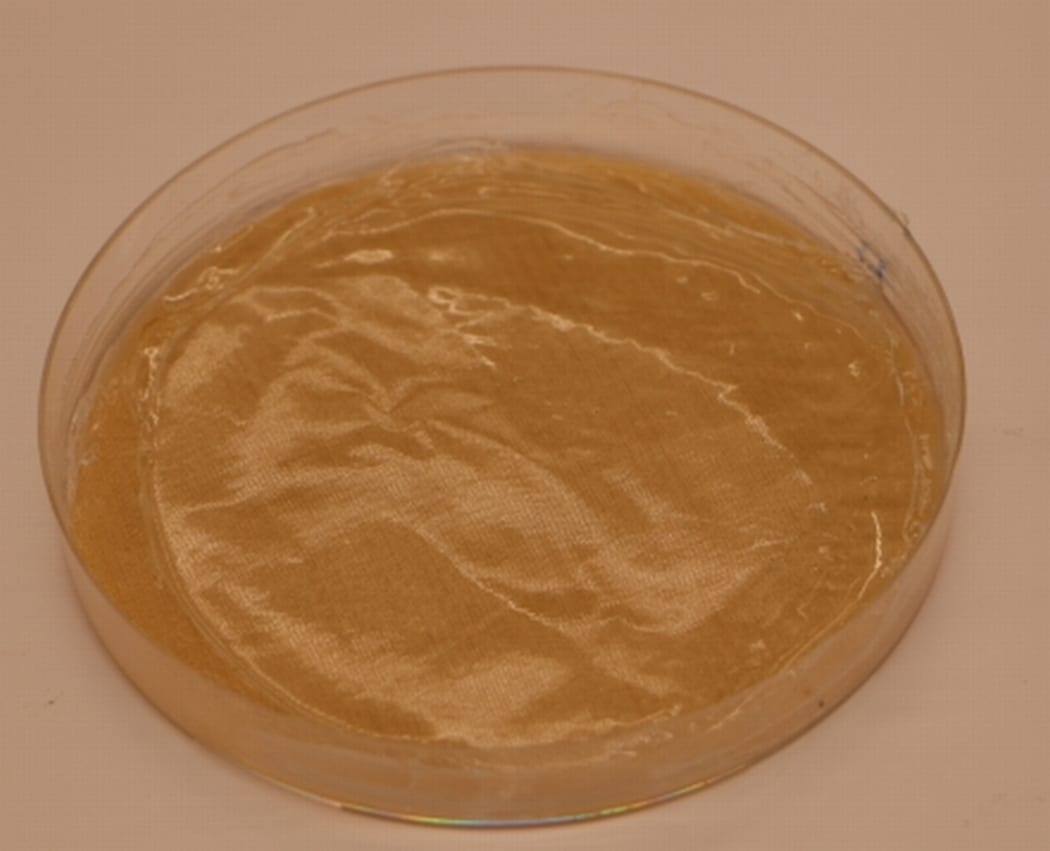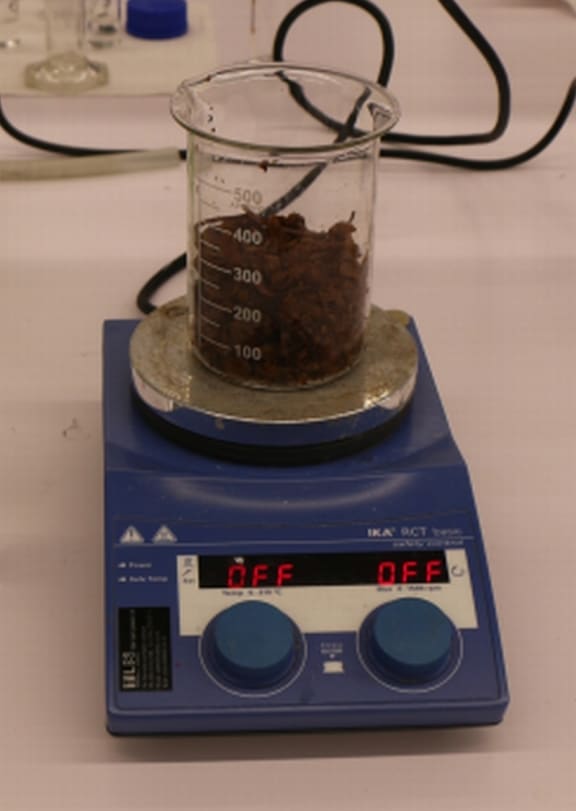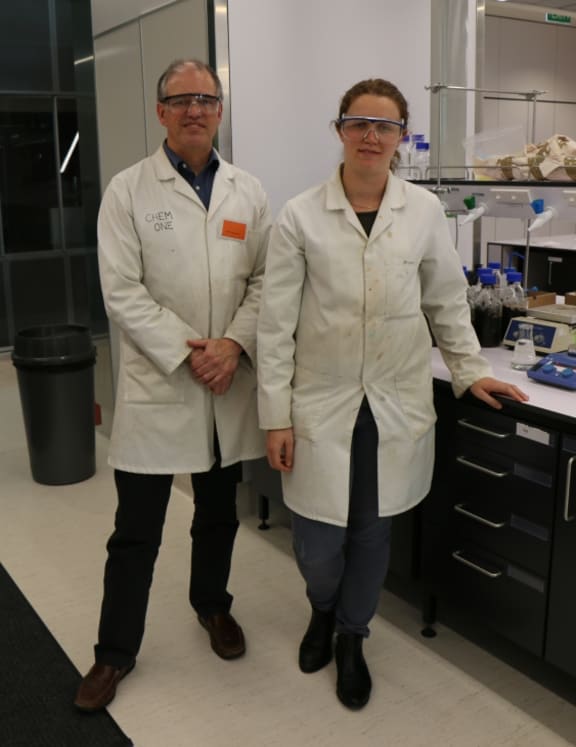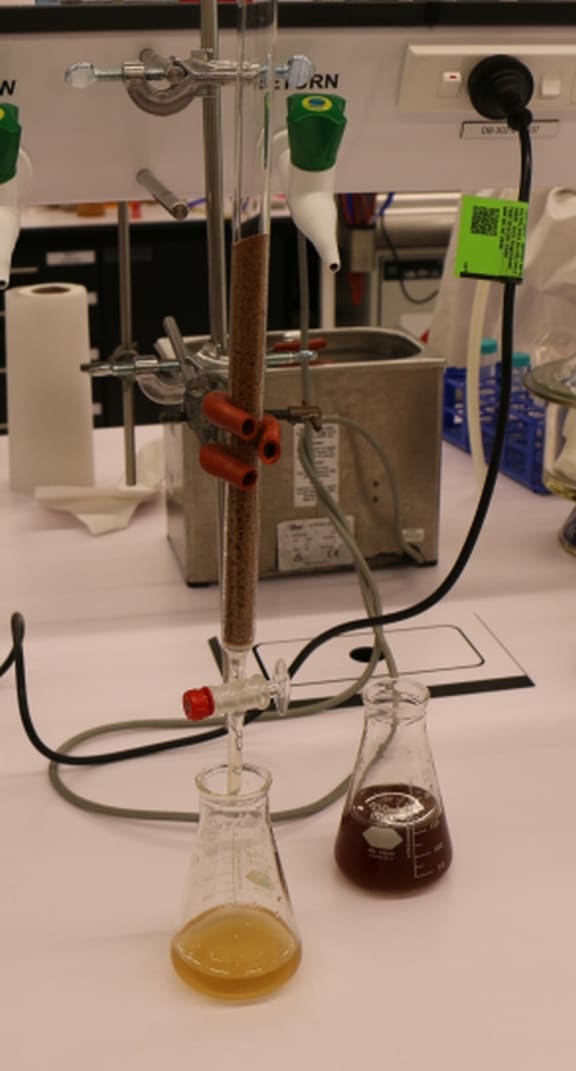We grow a lot of grapes here in New Zealand and, I think you will agree, make some rather good wine.
But a large and successful wine industry like ours means a lot of left-over wine waste, and finding a use for this unwanted by-product has proven, in the past, to be a problem. This is where chemist and wine scientist Paul Kilmartin comes in.
Professor Kilmartin leads a research group at the University of Auckland. Its aim is to turn this nearly useless by-product into biodegradable plastics with usable antibacterial properties.

This brown "film" has been made from tannin-rich wine waste. It has antibacterial properties and is ready for use in food packaging or storage. Photo: RNZ/Justin Gregory
Wine waste, often called marc or pomace, is made up of the skin, pulp and stems left over after grapes have been pressed for their juice. Traditionally, marc has been used as feed supplement for farm animals or as compost, but antimicrobial properties within the waste have given chemists and winemakers a reason to look twice at its disposal.
Tannins

The marc or waste. Photo: RNZ/Justin Gregory
The reason goes to the heart of wine: tannins. Tannins occur naturally in grapes and other plants and give some wines their dry, slightly bitter favour. Managing their presence is one of the keys to determining the final flavour of a wine.
As a natural antioxidant, tannins also help to preserve a wine as it ages and it is this aspect of them that makes their presence intriguing to Prof Kilmartin and his team.
Naturally enough, the waste created by wine making is also highly tannic as well as being full of sugar, amino acids and nitrogen.
While no one has exact figures on how much waste is produced here each year, Prof Kilmartin says winemakers are more than happy for his team to take the waste away and turn it into something else.

Professor Paul Kilmartin and PhD student Charlotte Vandermeer in the wine waste laboratory. Photo: RNZ/Justin Gregory
He believes this goal is in line with the future direction of the wine industry.
“They have a great focus on sustainability.”
The research, which is part of the Biocide ToolBox programme funded by the Ministry of Business, Innovation and Employment, is focused on creating a series of synthetic and natural biocides that are active chemical molecules which control or kill bacteria.
A possible application for these biocides is active packing; packaging that kills bugs on medical or food products and helps to extend their shelf life.

The marc being drained of any residual liquid. Photo: RNZ/Justin Gregory
Creating and testing the packaging
PhD student Charlotte Vandermeer is working under Prof Kilmartin to extract tannins from wine waste and from there create and evaluate packaging. It’s a four stage process and very green, using no organic solvents.
Water is added to the waste which is then spun for several hours, extracting all the usable tannins. Resin added to the water captures the tannins and after the liquid is removed, the extract is concentrated into a powder and turned into a polymer ‘film’, a plastic-like sheet that comes in varying shades of brown, depending on the tannin content.
This completely biodegradable film, which is environmentally harmless to produce, contains the antibacterial properties the team are after. From here it can be adapted for use in a bunch of different ways and the team believe that the film can easily replace non-environmentally friendly products already in use in our supermarkets and stores.
The next step is selling the biodegradable polymers to companies that might use them. Prof Kilmartin says they are mostly married to their oil-derived plastic products and he doesn’t expect them to move quickly. But the interest is already there.
“We’re talking to some different packaging companies and have been for some time. I think they’d like to see the proof of the pudding; they’d like to see these things working. So Charlotte will continue her testing, eventually with some real food examples.”
Tannin is one of many polyphenols found in grapes, and other research groups have also been looking at the antimicrobial properties of polyphenols in wine waste with a view to finding biomedical uses for it.

